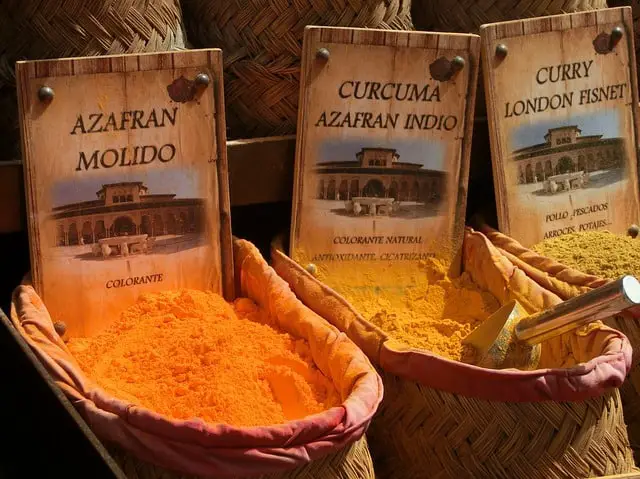You can combine saffron and turmeric in your culinary creations for a unique taste in various food dishes. Both saffron and turmeric are widely used spices known for their vibrant colors and distinct flavors, but they bring different characteristics to a dish as we’ll see below.
Combining Saffron and Turmeric Overview
- Saffron: Saffron is one of the most expensive and sought-after spices in the world. It is prized for its intense aroma, rich golden color, and delicate floral flavor. Saffron is commonly used in various dishes, including rice, risotto, stews, and desserts, to impart a luxurious and exotic touch.
- Turmeric: Turmeric is a bright yellow-orange spice with a warm, slightly bitter taste. It is often used in savory dishes, especially in Indian and Southeast Asian cuisines. Turmeric is known for its health benefits and provides a distinctive color to the dishes it is used in.
When combining saffron and turmeric, keep in mind the following:
- Colors: Both saffron and turmeric add a beautiful yellow hue to food, but saffron provides a more intense and golden color, while turmeric gives a vibrant yellow-orange tone.
- Flavors: Saffron has a delicate floral flavor, while turmeric has a warm and slightly bitter taste. The combination of these flavors can work well in certain dishes but might overpower others.
- Balance: Use these spices judiciously and strike the right balance based on the desired flavor and color in your dish. It’s a good idea to start with a small amount and adjust according to your taste preferences.
- Culinary Uses: Combining saffron and turmeric is more common in certain regional cuisines, such as Indian and Persian dishes. For example, you might find saffron and turmeric used together in rice dishes, curries, and stews.
When experimenting with spices in your cooking, remember that the flavors and colors can interact differently depending on the other ingredients and cooking techniques used. Try small test batches first to understand how the combination works in your specific recipes.
Dishes That Combine Saffron And Turmeric
Combining saffron and turmeric can add a beautiful blend of colors and flavors to various dishes. Here are some dishes from different cuisines that feature both saffron and turmeric:
- Saffron-Turmeric Rice: A fragrant and colorful rice dish where saffron-infused rice is complemented with a pinch of turmeric to enhance the yellow hue.
- Paella: A traditional Spanish dish, paella often incorporates both saffron and turmeric to flavor the rice and add a vibrant color to the seafood and meat.
- Biryanis: In Indian cuisine, biryanis often include saffron strands to impart a royal touch, while turmeric is used to color the rice and marinate the meat or vegetables.
- Middle Eastern Rice Dishes: Various Middle Eastern rice dishes, such as Persian Zereshk Polo or Moroccan saffron rice, might use a combination of saffron and turmeric for flavor and color.
- Moroccan Tagines: Some Moroccan tagines use saffron for a luxurious aroma, while turmeric adds a vibrant color to the stew.
- Indian Curries: While not all Indian curries use both spices, some recipes combine saffron with turmeric to create a visually appealing and flavorful curry.
- Saffron-Turmeric Infused Sauces: You can infuse cream-based sauces or broth with saffron and turmeric, giving them a golden color and a unique taste.
- Saffron-Turmeric Desserts: Some desserts, like Indian rice pudding (kheer) or Persian saffron ice cream, might use both spices for added richness and flavor.
When combining saffron and turmeric in dishes, it’s essential to be mindful of the flavors and quantities used, as both spices have distinct tastes. Start with small amounts and adjust according to your taste preferences to find the right balance. The result can be a visually stunning and aromatic dish that delights the senses.
Saffron And Turmeric Comparison
Here’s a comparison of saffron and turmeric in table form to show what each spice offers:
| Property | Saffron | Turmeric |
|---|---|---|
| Source | Saffron is derived from the saffron crocus flower (Crocus sativus). | Turmeric is the root of the turmeric plant (Curcuma longa). |
| Flavor | Delicate, floral, and slightly sweet. | Warm, slightly bitter, and earthy. |
| Color | Rich golden color. | Bright yellow to yellow-orange color. |
| Cost | Very expensive due to the labor-intensive process of harvesting. | Relatively affordable. |
| Culinary Use | Used in small quantities to add color and flavor to dishes, especially rice, stews, and desserts. | Widely used in various savory dishes, including curries, soups, and marinades. Also used as a natural food coloring. |
| Aroma | Intensely aromatic, with a unique fragrance. | Mild, with a slight peppery scent. |
| Health Benefits | Contains antioxidants and potential health benefits. | Known for its anti-inflammatory and antioxidant properties, thanks to the active compound curcumin. |
| Staining Properties | Saffron can stain dishes and hands if not handled carefully. | Turmeric can stain dishes, clothes, and surfaces. Be cautious when using it. |
| Origin | Originally from Southwest Asia. | Native to South Asia and widely cultivated in tropical regions. |
| Use in Traditional Medicine | Saffron has been used in traditional medicine for various purposes. | Turmeric has a long history of medicinal use in Ayurvedic and traditional medicine. |
| Other Uses | Used in perfumes, cosmetics, and herbal remedies. | Turmeric is also used as a dye for textiles and in traditional rituals. |
Both saffron and turmeric are unique and valuable spices with distinctive characteristics. Each one brings its own set of flavors, colors, and benefits to the table, making them valuable additions to various cuisines and culinary creations.


